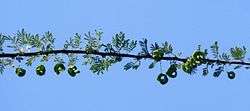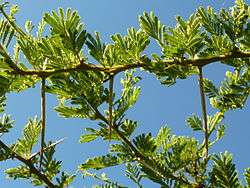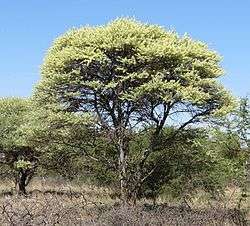Vachellia tortilis
Vachellia tortilis, widely known as Acacia tortilis but now attributed to the genus Vachellia,[3] is the umbrella thorn acacia, also known as umbrella thorn and Israeli babool,[4] a medium to large canopied tree native primarily to the savanna and Sahel of Africa (especially Somali peninsula, and Sudan), but also occurring in the Middle East.
| Umbrella thorn acacia | |
|---|---|
_tortilis.jpg) | |
| Specimen of the nominate subspecies in Serengeti National Park | |
| Scientific classification | |
| Kingdom: | |
| (unranked): | |
| (unranked): | |
| (unranked): | |
| Order: | |
| Family: | |
| Genus: | |
| Species: | V. tortilis |
| Binomial name | |
| Vachellia tortilis (Forssk.) Galasso & Banfi[1] | |
| subspecies[2] and varieties | |
| |
 | |
| Range of Vachellia tortilis | |
| Synonyms | |
Distribution and growing conditions
Vachellia tortilis tends to grow in areas where temperatures vary from 0 to 50 degrees Celsius and rainfall is anywhere from about 100–1,000 mm (3.9–39.4 in) per year.[5]
Characteristics
In extremely arid conditions, it may occur as a small, wiry bush. It grows up to 21 m (69 ft) in height.[6] The tree carries leaves that grow to approx. 2.5 cm (1 in) in length with between 4 and 10 pair of pinnae each with up to 15 pairs of leaflets. Flowers are small and white, highly aromatic, and occur in tight clusters. Seeds are produced in pods which are flat and coiled into a springlike structure.
The plant is known to tolerate high alkalinity, drought, high temperatures, sandy & stony soils, strongly sloped rooting surfaces and sandblasting. Also, plants older than 2 years have been observed to be somewhat frost resistant.
Importance
Timber from the tree is used for furniture, wagon wheels, fence posts, cages, and pens. Vachellia wood was also used exclusively by the Israelites in the Old Testament in the building of the tabernacle and the tabernacle furniture, including the Ark of the Covenant. The pods and foliage, which grow prolifically on the tree, are used as fodder for desert grazing animals. The bark is often used as a string medium in Tanganyika, and is a source for tannin. Gum from the tree is edible and can be used as Gum Arabic. Parts of the tree including roots, shoots, and pods are also often used by natives for a vast number of purposes including decorations, weapons, tools, and medicines.[7]
The Umbrella thorn is also an important species for rehabilitation of degraded arid land; it tolerates drought, wind, salinity and a wide range of soil types, and has the additional benefit of fixing nitrogen - an essential plant nutrient - in the soil via its interaction with symbiotic root bacteria.
Common names



Spread over such a large area inhabited by diverse cultures, the V. tortilis is known by a wide number of common names. These include (but are not limited to):[8]
- Afrikaans: haak-en-steek
- Amharic: Grar
- Arabic: samr, samar, sammar, samor, samra, sayyal, seyal, seyyal, sunut
- English: karamoja, umbrella thorn
- Beja: tawaay
- Hebrew: shitat ha'sochech
- Hindi: Israeli babool
- Italian: acacia ad ombrello
- Kamba: mùgaa
- Ndebele: isanqawe, umsasane, umshishene, untshatshatsha
- Nyanja: mzunga, nsangu, nsangunsangu, nyoswa
- Oromo: Lafto
- Samburu: ltepes
- Somali: qudhac
- Spanish: Acacia de copa plana
- Swahili: mgunga, mugumba, munga
- Tigrigna: akba, akiba, alla, aqba
- Tongan: mukoka, muzungu, ngoka
- Tswana: mosu, mosunyana
- Urdu: kikar(کیکر), Babol(ببول)
- Wolof: séng
- Zulu: umSasane
See also
- Arid Forest Research Institute (AFRI)
- Ecosia Search Engine That Plant Trees
References
- Kyalangalilwa B, Boatwright JS, Daru BH, Maurin O, van der Bank M (2013). "Phylogenetic position and revised classification of Acacia s.l. (Fabaceae: Mimosoideae) in Africa, including new combinations in Vachellia and Senegalia". Bot J Linn Soc. 172 (4): 500–523. doi:10.1111/boj.12047.
- ILDIS Legumes of the World
- XVIII International Botanical Congress, 23–30 July 2011, Melbourne Australia
- Vachellia tortilis (as Acacia tortilis (Forsk.) Hayne), Purdue University, December 1997.
- "handbook on seeds of dry-zone acacias". www.fao.org. Retrieved 2017-08-03.
- World Agroforestry Centre
- "Acacia tortilis". www.hort.purdue.edu. Retrieved 2017-08-03.
- World AgroForestryTree Database: ICRAF / PROSEA network.
External links
| Wikimedia Commons has media related to Vachellia tortilis. |
| Wikispecies has information related to Vachellia tortilis |
- Vachellia tortilis (as Acacia tortilis) (www.fao.org)
- Purdue University's detailed article on the Umbrella Thorn Acacia.
- Vachellia tortilis (as Acacia tortilis) (www.frienvis.nic.in)
- Acacia tortilis in West African plants – A Photo Guide.
- Vachellia tortilis (as Acacia tortilis) Israel wildflowers and native plants